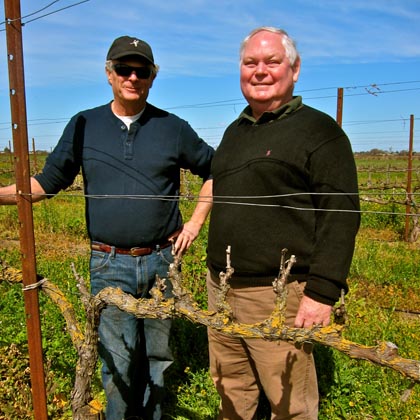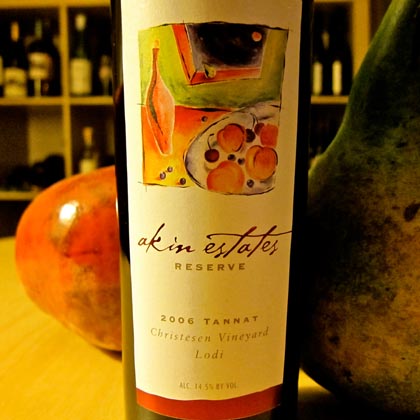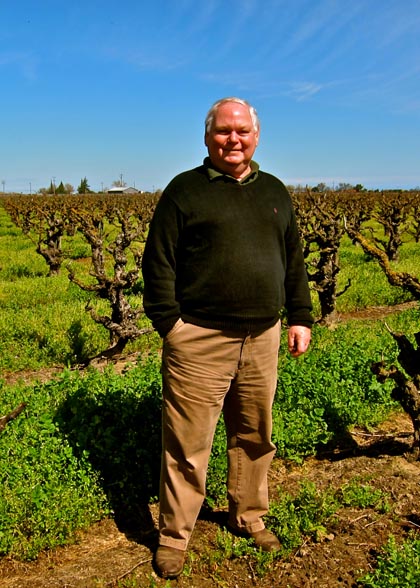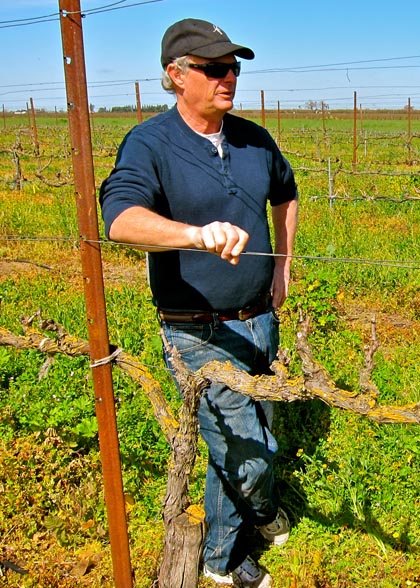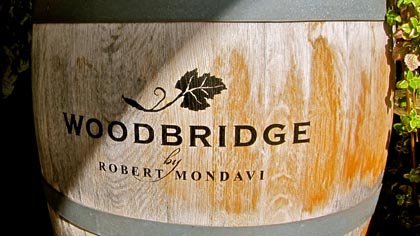Letters from Lodi
An insightful and objective look at viticulture and winemaking from the Lodi
Appellation and the growers and vintners behind these crafts. Told from the
perspective of multi-award winning wine journalist, Randy Caparoso.
Akin Tannat is truly like none other
Dick Williams & David Akin in the Christesen Vineyard
Lodi’s customary cutting edge…
Lodi is so far out ahead in many aspects of winegrowing, most folks aren’t even aware of it. Most wine “experts” don’t know either — otherwise, you’d be reading about it in more places.
Perfect example: The 2006 Akin Estates, Christesen Vineyard Reserve Tannat — a red wine so bodaciously full, rich and meaty, you can practically eat it with a spoon while savoring its smoky, viscous flavors, redolent of fleshy plums, bing cherry and blackberry, with smidgens of sexy leather and dusty loam.
Tannat, we say? Think of a black skinned grape that produces a red wine with the body and muscle of a Cabernet Sauvignon, but without the green herby, bell peppery qualities often associated with cabernets. Or a red wine with the zippy blackberry/raspberry fruitiness of a good Zinfandel, but without the raisiny sweet tones often found in bigger zins.
Even Akin Estates winemaker/proprietor David Akin wasn’t completely aware of the grape until about five years ago, despite the fact that he’s been a winemaker and oenological consultant by profession since the early seventies, when he got his start at Paul Masson (that venerable old winery where, once, no wine was sold “before its time”).
Akin, as it were, was always a frequent visitor to South America, relishing the wines and cultures of those countries. One day, he tells us, he was at a winery in Argentina, where he was poured a particularly fine, full, fragrant red wine that reminded him somewhat of a Syrah, but clearly wasn’t a Syrah. “What is this?” he asked. The Argentine vintners replied, “this is made from Tannat, the grape that goes into most of the best wines of Uruguay.” “The funny thing,” Akin tells us, “I had been enjoying red wines from Uruguay for many years, and didn’t know that they were made mostly from Tannat.”
Coming back home to Lodi, Akin ran into an old winegrower friend, Dick Williams, who manages over 100 acres for the Christesen family, who’ve been farming in the Delta since the 19th century. Akin told Williams about his exciting “discovery,” and Williams’ response was… “Tannat? I just grafted three and a half acres of Tokay over to Tannat in our vineyard at Vine St. (near the corner of Lower Sacramento and Hwy. 12)… interested?” “My goodness, I’d love some,” said Akin, and in 2006 he crushed his first batch of Tannat from the Christesen Vineyard.
Here’s where the story — or actually, the wine — gets juicier: it’s been theorized that Tannat is so named because of its propensity to produce wines that are high in tannin — the phenolics found in the skins, seeds and stems of wine grapes, which give red wines their bitter taste (or astringent, when the wine is unbalanced). In its original home, for instance, the Tannat based reds of South-West France’s Basque regions — notably, the Madiran and Irouléguy appellations — are certainly known for their black, beefy, earthy, often palate jarring tannin and intensity.
Akin, however, did his homework, conferring with his winemaker friends in Argentina before diving full bore into Tannat. “I was advised to taste the juice repeatedly while it ferments, and as soon as you start to feel the tannin, then you press — you need to separate the skins from the fermenting juice before too much tannin is extracted. In 2006 we pressed at 3.5° Brix (i.e. reading of unfermented residual sugar), and if we’d’ve waited another day, the wine would have been undrinkable. Once the wine finished fermenting without the skins, we rounded it out further for 20 months in French oak — a third of it in brand new oak, which Tannat is rich enough to handle.”
As for Mr. Williams: what even possessed him to grow Tannat, when there were probably at least two dozen other grapes of more obvious commercial appeal that he could have put into the Christesen Vineyard? “I don’t know,” says Williams. “Maybe it was a case of, why not Tannat? I had a friend who had the cuttings, but changed his mind about growing it and planted cherry trees instead. So we took it, and we’ve been selling it all — some of it to David, but mostly to Woodbridge.”*
Along with Williams, Lodi’s Ernie Dosio, Ron Silva at Silvaspoons Vineyard, and the Phillips family at Michael-David Winery have also devoted substantial acreage to Tannat; Lodi’s total adding up to over half of the 140 or so total acres planted in all of California (see our previous posts, Lodi’s Portuguese Grape King and Lodi’s uncommonly dark, intense Inkblots).
Adds Akin, “Tannat is a good producer. In most years, the bunches can be huge, coming in at high sugar and at the same time, unheard of levels of pH and acidity — typically, around 25° Brix, with +1.0 total acidity. The high acid drops out during fermentation, though, and all you really get is good, fresh red wine, full and rich without being sharp or astringent.”
Nevertheless, Akin admits, Tannat can be a challenge for newbies. “It’s still a love-it-or-dislike-it wine,” he says, “although we recently had a Sacramento television personality taste it, and her response was, to be or Tannat to be…” Okay — we’ll let Akin slide on that one…
Ultimately for Akin, though, it is the rich, dense viscosity of Tannat that truly makes it like none other on the table. “Tannat has been my favorite wine to cook with. It’s especially beautiful with braised meats — tonight I’m having oxtail stew with it, which is absolutely a perfect pairing.”
On a final note, you can experience Akin’s Tannat for yourself at Woodbridge Uncorked, a tasting room/co-op in the historic little hamlet of Woodbridge (adjoining Lodi). Whatever your response, you will have tried something totally… different — in that sense, very Lodi!
*Visitors to the tasting room at Woodbridge by Robert Mondavi can find Williams’ Tannat fruit artfully blended into the 2008 Woodbridge Cherokee Station — a full bodied, briary, blackberry/black cherryish red wine (40% Tannat) selling for just $12.
